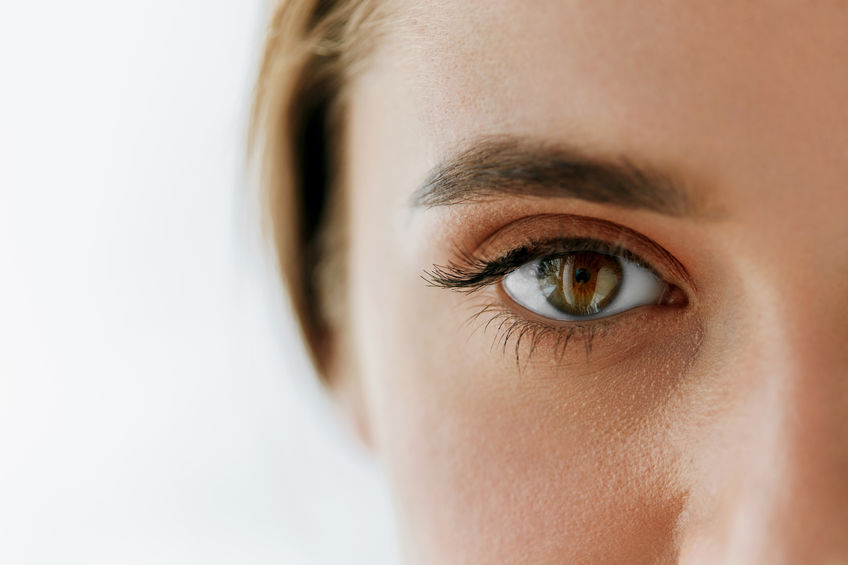There are many ways in which you can keep your eyes healthy. Learn more about how Ayurveda helps to keep eyesight healthy.

The ancient science of Ayurveda is an integral form of medicine and healthcare which primarily aims at the prevention of disease and promotes positive well-being. Its holistic approach towards lifestyle and health makes it vital in the modern-day scenario. Intensive eye care is described under “Shalakya Tantra”, one of the eight parts of Ayurveda. It also offers numerous safe, effective and simple methods for maintaining ocular health. Although these approaches are primitive, they are viable and can still be easily practiced in our daily lives to avoid lifestyle-related eye disorders.
Ayurvedic Treatments For The Eyes
Eyes are critical for one’s quality of life. They are the windows to the soul and yet most people do not pay much regard to their care. The eyes usually get attention when there is a problem and one seeks Ayurvedic treatment for eye problems. We put our eyes through stress with the overuse of digital devices and exposure to too much light. This is not often balanced out with adequate eye care practices. Diseases such as diabetes that are aggravated by poor lifestyle choices and habits also adversely impact our eyes.
Just as the whole body is a combination of all the elements, the parts of the eye are also related to elements. The muscles in the eye are governed by the earth element, the blood vessels by fire, eye color by air, the eye white by water, and the tear ducts and channels by space. Eyes are the seat of the Pitta Dosha. The Alochaka Pitta, in particular, governs the eye and since the Pitta Dosha gets more unbalanced with age, advancing age affects the eyes.
The eyes and their care are described in the ancient Ayurvedic texts. Good eye care habits help to keep the eyes healthy and vision clear. Ayurvedic wisdom states that the eyes should be bathed with cool water in the morning while holding water in the mouth at the same time. Very hot or very cold water should not be used on the eyes. Staring intensely at a ghee lamp that has been lit with a cotton wick is an Ayurvedic medicine for eye vision improvement. It adds strength to the vision and improves eye luster. A good way to soothe tired eyes is to place cotton soaked in fresh goat’s milk over them.
A simple Ayurvedic treatment for dry eyes is a drop of pure castor oil on each eye along with the oil applied on the soles of the feet. Cucumber slices are also an Ayurvedic treatment for eye care and soothe the eyes with their cooling moist effect. Ayurvedic treatment for glaucoma includes the use of traditional ingredients such as Amla and Punarnava. Ayurveda treats all health issues holistically and glaucoma is defined as a Kapha Dosha problem. It is treated both externally and with internal medication in Ayurveda. Herbal mixtures such as Triphala have been described in ancient texts as Ayurvedic medicine to improve eyesight. Triphala is administered orally or in the form of Ayurvedic eye drops as required.
Certain Yoga exercises for the eyes can be a supplement to Ayurvedic medicine for eye vision improvement. One must sit in the Sukhasana and roll the eyes upward, then downward, left, and then right. This should be repeated several times. When using a computer or watching TV, take occasional breaks and look away from the computer. Alternatively focusing on something near and then something far away gives your eyes some relief. Dry eyes are caused by an aggravated Vata Dosha and this should be managed with Ayurvedic treatment for dry eyes and an appropriate diet. Preventive treatment is the best Ayurvedic treatment for eyes and their health.
Importance of Eye Care in Ayurveda
The eye is considered as one of the most vital organs of the body because vision plays a crucial role in the social and intellectual development of a person. Moreover, about 80% of the knowledge we gain is through the eyes only. So, our existence and status in this universe are directly influenced by the eye.
Many of the eye problems can be eliminated by avoiding faulty lifestyles. Smoking, tobacco and alcohol consumption, high fat diet and junk food, chronic stress, prolonged exposure to bright light from computer and TV screens are a few examples that damage the eye health. Clinical conditions like ARMD, diabetic/hypertensive retinopathy, computer vision syndrome, may occur as a result as well. According to Ayurveda, the eye diseases can be prevented, and proper vision can be maintained for a long time by following specific points in life, such as dinacharya, ritucharya, sadhvritta, swasthavritta, and taking chakshyusya rasayana.
- Dinacharya: From the perspective of Ayurvedic sciences, following a proper dinacharya or daily routine puts us in alignment with nature’s rhythms and helps us to maintain overall health
- Ritucharya: Ritucharya or seasonal routine consists of a lifestyle and Ayurvedic diet regimen and discipline to deal with the mental and physical impacts caused by seasonal changes
- Sadhvritta: Sadhvritta is the behavioural and moral principles that help a human being to live a healthy and stress-free life
- Swasthavritta: It embraces all the factors of dinacharya, ritucharya, ratricharya, sadhvritta to achieve the goal of perpetual health and happiness
- Chakshyusya Rasayana: Chakshyusya Rasayana or Ayurvedic medicine for eyes can be administered along with other therapies and practices to improve the condition and prevent disorders of the eye
Ayurvedic Home Remedies for Better Eye Care
Ayurveda describes several ways to maintain the strength and health of your eyes.
Cool water wash

When you wash your face in the morning, Ayurveda recommends splashing cold water on the eyes while holding water in your mouth. This makes your eyes feel fresh. You can also use an eyecup to cool your eyes.
Ghee lamp
Gazing into the flame of a ghee lamp is a traditional Ayurvedic eye care method followed for centuries to strengthen and soothe the eyes. To prepare a ghee lamp, use a small bowl of ghee and place a cotton wick in it. Using a wick made of genuine cotton is better.
Now, light the wick and place the lamp two or three feet away from you. Gaze at the flame for a minute or two without blinking. It is known to improve the lustrous quality of eyes.
Goat milk to reduce eye strain

Ayurveda suggests that dipping a cotton ball or a piece of gauze in goat’s milk and putting it on the eyes can relieve eye strain and make them feel better.
Castor oil
Put a drop of castor oil on each eye before going to bed. Make sure to use an oil with no preservatives. Also, rub some oil into the soles of your feet. You will wake up with fresh and bright eyes.
Cucumber slices

Cucumber is well known for its anti-irritation properties. When applied to the eyes, it can help in reducing inflammation, puffiness, swelling, and irritation. As it has high water content, they work as a useful Ayurvedic remedy for dry eyes.
Home remedies for certain eye conditions
- Conjunctivitis: Amla is an excellent remedy for dealing with conjunctivitis. You can also prepare a decoction from coriander and use it as an eyewash to reduce burning, swelling, and redness
- Burning sensation in eyes: Take a cotton pad and soak it in rose water, milk or aloe vera juice. Let the cotton pad stay on your closed eyes for about ten to twenty minutes
- Stressed and dry skin around the eyes: Gently rub a drop of almond oil above and under the eyes to keep it smooth and ease the stress
- Redness: Application of a paste of milk and castor oil or sandal and milk is a beneficial Ayurveda eye treatment
Herbs for Better Vision & Ayurvedic eye care
Degeneration of eye health and loss of vision can occur due to a variety of factors. But with Ayurveda, balanced nutrition and avoidance of certain behaviours, you can keep your eye health in check. Many pieces of evidence have shown that specific nutrients can strengthen the eye muscles and improve eyesight, but more research needs to be conducted to prove its significant benefits.
Ayurvedic medicines and therapies have been used for millennia for the treatment and prevention of several conditions affecting the eyes. Moreover, one of the earliest surgical procedures for cataract also was described by the Indian physician Sushruta, over two thousand years ago. Ayurveda primarily focuses on the overall well-being of the body, and the treatments it suggests are entirely natural and less invasive. The ancient science uses various methods to correct body imbalances by the use of herbs, both externally and internally. Some of the popular herbs used in Ayurvedic eye care solutions are as follows.
Triphala

Triphala is a potent herbal formula that consists of three fruits – Amla (Emblica Officinalis), Bibhitaki (Terminalia bellirica) and Haritaki (Terminalia chebula). Each fruit is known to impact the three doshas of the body positively. Triphala has strong medicinal properties and is widely used in Ayurvedic medicines to lower toxicity levels in the body and support general health. It is usually ingested, but to address eye-related concerns, it can also be topically applied in the form of eye drops.
The therapeutic effects of triphala are backed up by modern-day science and research. It has been proven that the administration of triphala eye drops can potentially reduce problems like eye inflammation, redness, and strain. Moreover, triphala is rich in vitamin C and antioxidants, which can protect the eyes from damage associated with oxidative stress.
You can receive the benefits of this herbal preparation by consuming triphala powder, tea, capsules or extract.
Ginkgo Biloba
The Ginkgo Biloba is a plant native to China. The therapeutic properties of the plant are useful in the treatment of a variety of conditions, such as memory problems, blood disorders, and improving eye health. The Ginkgo Biloba extract used in herbal remedies is taken from the dried green leaves of the plant and made into liquid extracts, capsules, and tablets.
As a natural antioxidant, the herb is often recommended to strengthen eye health and protect vision. Certain studies have shown its effectiveness in the treatment of glaucoma also. Due to its neuroprotective and vascular regulating effects, Ginkgo can be used as an adjuvant therapy to deal with normal or high-tension glaucoma.
Bilberry
The bilberry plant is characterized by bright green leaves and bell-shaped flowers. It grows primarily in northern Europe and is related to cranberry, huckleberry, and American blueberry. Bilberry stands out among other herbal remedies for eye care as it is known to improve both normal and night vision. It can reduce vascular permeability, capillary fragility and protect against cataracts, glaucoma and macular degeneration.
Passionflower
The Passionflower is a climbing vine that can be found in the south-eastern United States and Central and South America. The parts of the plant above the ground are used to make medicine. Passionflower is used to treat insomnia, anxiety, ADHD, pain, burns and contributes significantly to the improvement of eyesight conditions in Ayurvedic medicine. It relaxes the blood vessels in the eye and helps to maintain proper eye health. Additionally, it is a potent nerve relaxer as well. It reduces the tension in the eye nerves, thereby improving the ability of the eye to focus clearly and function better.
Calendula
Though Calendula is used in the treatment of several problems like muscle spasms, fever, inflammation, leg ulcers, etc., it is also a potent herbal remedy for managing various eye issues. Calendula is also called pot marigold, and due to its antibacterial, antiviral and anti-inflammatory properties, it is used to manage eye conditions, such as conjunctivitis, allergies, general eye irritations, minor eye injuries and redness or swelling of the eye.
Fennel seeds and almond
Fennel seeds and almonds are often used as the ingredients of various Ayurvedic medicines for eye health. Although many pieces of evidence suggest that nutrients in fennel seeds and almonds promote healthy vision, more research needs to be done to support the claim that they can improve eyesight. People have been using this Ayurvedic eye care remedy for centuries, and it poses no known risk.
If you would like to give it a try, you can do it as mentioned below.
- Take fennel seeds, almonds, and rock sugar in equal amounts.
- Grind them thoroughly and store the mixture in an airtight container.
- Add two teaspoons or ten grams of the powder to a cup of warm milk and drink it preferably before going to bed or on an empty stomach in the morning.
Home-made herbal eyewash
A home-made herbal eyewash can be a great way to deal with minor eye irritation when you need a quick fix or can’t reach a medical store. Follow the steps mentioned below to make your natural eyewash.
- Take half a teaspoon of organic Triphala powder and mix it in a cup of boiling water. It's better to use distilled water instead of tap water.
- Let the solution cool down, and then strain the particles with a clean cloth.
- Now dip a small towel in the solution and place it over your eyes.
- Blink frequently to enable the solution to enter your eyes.
- You can soak your eyes in the eyewash for around five minutes and pat it dry. It is recommended to do it before going to bed.
Rosewater is commonly used in Ayurvedic and Unani medicine for its antiseptic and antibacterial properties. It can be used as a soothing eye rinse as well. To create your own rose water eye drops, mix one teaspoon of organic honey with three tablespoons of organic rose water in a jar or bottle. Use a dropper to apply it to your eyes. Before preparing your eye drops, check whether the natural rose water has any added ingredients or chemicals as they may cause further irritation.
Improve Eyesight Naturally with Yoga

Yoga exercises have the potential to maintain the optimum health of all our organs. These exercises can also help to deal with various eye health issues such as short-sightedness and long-sightedness. Most of the eye disorders occur due to the malfunctioning of the ocular muscles caused by chronic mental and emotional tension. By following simple yoga techniques like palming and blinking, you can alleviate disorders caused due to defects in the eye muscles.
Here are a few yoga exercises that are simple and yet powerful. Regularly practicing these exercises can help to relax the eye muscles and make them healthier and stronger.
Before you start any of these exercises, you must wash your eyes thoroughly with cold water. Make sure that your head and spine are straight throughout the exercises.
Palming
Palming is not exactly an exercise, but an ancient yoga relaxation technique quite similar to meditation. You can start by sitting on a comfortable chair, maintaining a straight posture and then follow the steps.
- Sit quietly in a dark room and close your eyes. Let your elbows lean comfortably on a table and relax your back and shoulders.
- Now rub the palms of the hands vigorously until they become warm. Place them gently over your eyes.
- You don’t have to press the eye sockets. Just visualize total darkness and let your palms sit there until your eyes have completely absorbed the heat.
- Keeping your eyes closed, lower your hands and repeat the process for at least three times or as long as it’s comfortable.
Blinking
Proper blinking is necessary to clean your eyes, relieve the strain and improve eye comfort. You can set aside a few minutes every day for the following blinking exercises.
- Find a place to sit down comfortably. Start blinking quickly for ten seconds and then relax for twenty seconds by closing your eyes. Also, pay attention to your breathing. You can repeat this exercise for about five times.
- You can do the above exercise by looking at all five directions – up, down, left, right, and straight. It is essential to ensure that your blink is complete to be effective.
Sideways viewing
- Sit comfortably and place your legs straight in front of the body.
- Close your fists with your thumbs pointing upward
- Now raise your arms and focus on a point that’s in level with your eyes
- Then you can shift your vision on the following points one after the other
- Space between the eyebrows
- Left thumb
- Space between the eyebrows
- Right thumb
- You can repeat this exercise for about ten to twenty minutes.
- After you are done with the exercise, close your eyes and rest.
- While performing the exercise, remember to inhale in a neutral position and exhale while looking to one side.
Up and down viewing
- Start by sitting with legs straight in front of your body.
- Close your fists with your thumbs pointing upwards and place them on the knees.
- Keep your arms straight and slowly lift the right thumb.
- Focus on the thumb and follow its motion upwards.
- When your thumb is raised to a maximum, gradually bring it down to the initial position.
- Now repeat the process with the left thumb.
- After you complete the exercise, close your eyes and relax.
- You have to inhale while raising the eyes and exhale as you lower them down.
Rotational viewing
- Sit with your legs straight in front of your body
- Close your fist with your thumbs out as you did with the earlier viewing exercises.
- Place the right fist above the right knee and focus your eyes on the thumb.
- Keep your elbow straight and make a circle with the thumb.
- Move your thumb in both clockwise and anti-clockwise directions.
- Now repeat the process with your left thumb.
- Close your eyes and rest after you finish the exercise.
Preventive Measures for Better Eye Care
Ayurvedic literature puts more stress on the preventive aspect of treatment. Therefore, the first step to treat disease must be focused on eliminating the factors that contribute to the disease. Ayurvedic scholars have prescribed specific aahara (diet), aushada (drugs), and vihara (daily regimen) for the prevention of eye diseases. They are described as follows.
Aahara or diet

Your diet is important for the proper functioning of the body and its organs. The dietary factors that negatively affect the eyes are:
- Sour items like curd, pickles, etc., and hot items that vitiate pitta
- Virudha aharam or food that contains items with cooling and hot properties
- Eating a meal before the complete digestion of the previous meal
To maintain proper eye health, one must always adhere to diets consisting of barley, wheat, red rice, green gram, vegetables, pomegranate, rock salt, pure cold water, etc.
Vihara or habitual factors

Certain habitual factors that impact eye health are:
- Hot water head baths
- Smoking
- Sleeping in the day and staying up late at night
- Looking at TV and computer screens for a prolonged period
- Suppressing the urge to sleep
- Air pollution
We should try to avoid these leading factors of eye diseases at all costs. We must also follow some of the practices for daily regimen as advised by Ayurveda are:
- Use of Anjana: Anjana is an Ayurvedic paste applied to the inner part of the eyelids to promote good eye health.
- Adequate sleep: Restful is important for a healthy life. During sleep, your eyes get the rest needed to retain their functional capacity.
- Feet care: According to Ayurveda, regular massage of the feet can significantly benefit eye health and vision.
- Eyewash: Using Triphala eyewash or an eyewash cup is also beneficial for eye health.
- Eye exercises: Set aside a few minutes in a day to perform simple eye exercises like moving them up-down, sideways, and in clockwise-anticlockwise directions. Palming is an excellent technique as well that can help in preventing refractive errors.
- Shatkarma: Ayurveda describes six purification techniques or shatkarmas to clean the body of toxins, strengthen it and make it free of diseases. Out of them, neti and tratak work as the best Ayurvedic remedy for dry eyes and eye health.
Neti is done by using plain warm saline water to clean the nasal tract of impurities. Trataka involves gazing at a candle flame without blinking so that the tears naturally cleanse your eyes.
Winding Up
We live in a world that is brimming with visual information, and our eyes are arguably the most overworked of all our senses. Additionally, the rising level of pollutants and airborne toxins in our environment puts our eyes at great risk of disorders and problems. Therefore, it is imperative to have a regular eye care routine and adopt Ayurveda eye treatment practices to offset some of the risks.
FAQ's
1. You can help improve your eyesight naturally with the help of Ayurvedic medicine to improve eyesight as prescribed by the physician.
There are different ways of improving your eyesight naturally. Some of them are:
- Sunbathing can be helpful. Expose yourself to the natural sunlight for some time. You must do this only at the time of sunrise or sunset, else your eyes may be damaged by the harmful rays of the sun.
- A Yoga practice known as Tratak can help improve eyesight naturally. You need to focus on a candle flame looking at it with your little finger. Do this for 2 or 3 minutes without blinking your eyes.
- Including cucumbers, carrots, spinach, beetroot, tomatoes, and almonds in the diet can help improve eyesight naturally.
- Splashing cold water on the eyes early in the morning can make you feel fresh and it may help improve your eyesight.
- Cucumber slices can be placed on closed eyes while lying down for a few minutes. This helps during symptoms like dry eyes.
2. How do you keep your eyes healthy?
You can help keep your eyes healthy through a combination of diet and by taking Ayurvedic herbs that strengthen eyesight. Yogasanas like Trataka can help improve eye health. Palming can help reduce the stress on the eyes. It can be done by rubbing the hands together for ten seconds to warm them up. The warmed hands should then be placed over the eyes. This helps improve blood circulation to the eyes.
3. Which food is good for the eyes?
Almonds, cashew nuts, groundnuts, walnuts, and lentils are helpful for the eyes. They have Vitamin E and Omega-3 fatty acids that are good for the eyes. All leafy green vegetables including spinach are beneficial for the eyes and should be included in the diet since they contain Vitamin C, which is helpful for the eyes. Carrots are rich in Vitamin A and beta carotene and must be a part of the diet. Similarly, sweet potatoes are helpful for the eyes and also have good fibre content that is beneficial for general health. Apart from food, water is important. It keeps the body hydrated and helps to avoid dry eyes.
4. How do I look after my eye health?
You can look after your eye health in various ways. One is by taking helpful Ayurvedic medicine to improve eyesight like Triphala, Shatavari, Amalaki, and Bhringraj. The juice from garlic can be consumed. Honey mixed with pepper powder is another home remedy to help improve eye health. Apart from this, measures like rubbing ghee on your soles are believed to help improve vision. There are many exercises that can be done to help improve vision. Apart from all these, it is recommended to visit an eye doctor at least once a year or once in two years.
5. Which fruit is best for the eyes?
The fruits that are good and helpful for the eyes include the following:
- Orange, that is rich in Vitamin C.
- Apricot, which has rich beta-carotene content.
- Avocado protects the eyes from the harmful rays of the sun.
- Mango that is rich in Vitamin A.
- Papaya, which has a lot of antioxidants and enzymes.
If you would like to go for a more systematic approach to help maintain your eye health, Ayurvedic medicine and therapies to improve eyesight prescribed by the physician can be a good way.
https://www.keralaayurveda.biz/blog/an-ayurvedic-guide-to-improved-eyecare#:~:text=You%20can%20look%20after%20your,to%20help%20improve%20eye%20health.








Comments
Post a Comment